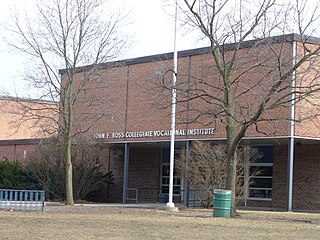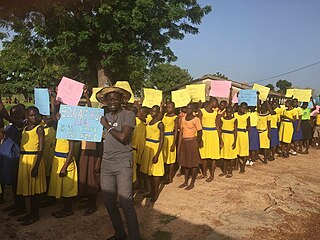
Vocational education is education that prepares people for a skilled craft as an artisan, trade as a tradesperson, or work as a technician. Vocational education can also be seen as that type of education given to an individual to prepare that individual to be gainfully employed or self employed with requisite skill. Vocational education is known by a variety of names, depending on the country concerned, including career and technical education, or acronyms such as TVET and TAFE.

A teacher, also called a schoolteacher or formally an educator, is a person who helps students to acquire knowledge, competence, or virtue, via the practice of teaching.

Physical education, often abbreviated to Phys. Ed. or PE, and sometimes informally referred to as gym class or simply just gym, is a subject taught in schools around the world. PE is taught during primary and secondary education and encourages psychomotor, cognitive, and effective learning through physical activity and movement exploration to promote health and physical fitness. When taught correctly and in a positive manner, children and teens can receive a storm of health benefits. These include reduced metabolic disease risk, improved cardiorespiratory fitness, and better mental health. In addition, PE classes can produce positive effects on students' behavior and academic performance. Research has shown that there is a positive correlation between brain development and exercising. Researchers in 2007 found a profound gain in English Arts standardized test scores among students who had 56 hours of physical education in a year, compared to those who had 28 hours of physical education a year.

Education in Sweden is mandatory for children between ages 5/6 and 15/16 depending on when in the year they were born. The school year in Sweden runs from mid–late August to early/mid–June. The Christmas holiday from mid–December to early January divides the Swedish school year into two terms.

A preschool, also known as nursery school, pre-primary school, play school or creche, is an educational establishment or learning space offering early childhood education to children before they begin compulsory education at primary school. It may be publicly or privately operated, and may be subsidized from public funds.
Special education is the practice of educating students in a way that accommodates their individual differences, disabilities, and special needs. This involves the individually planned and systematically monitored arrangement of teaching procedures, adapted equipment and materials, and accessible settings. These interventions are designed to help individuals with special needs achieve a higher level of personal self-sufficiency and success in school and in their community, which may not be available if the student were only given access to a typical classroom education.
The educational system in Taiwan is the responsibility of the Ministry of Education. The system produces pupils with some of the highest test scores in the world, especially in mathematics and science. Former president Ma Ying-jeou announced in January 2011 that the government would begin the phased implementation of a twelve-year compulsory education program by 2014.
This is an index of education articles.
Universal Design for Learning (UDL) is an educational framework based on research in the learning sciences, including cognitive neuroscience, that guides the development of flexible learning environments and learning spaces that can accommodate individual learning differences.
Education in Norway is mandatory for all children aged from 6 to 16. Schools are typically divided into two divisions: primary and lower secondary schooling. The majority of schools in Norway are municipal, where local governments fund and manage administration. Primary and lower secondary schools are available free of charge for all Norwegian citizens as a given right.
This glossary of education-related terms is based on how they commonly are used in Wikipedia articles. This article contains terms starting with T – Z. Select a letter from the table of contents to find terms on other articles.

Inclusion in education refers to all students being able to access and gain equal opportunities to education and learning. It arose in the context of special education with an individualized education program or 504 plan, and is built on the notion that it is more effective for students with special needs to have the said mixed experience for them to be more successful in social interactions leading to further success in life. The philosophy behind the implementation of the inclusion model does not prioritize, but still provides for the utilization of special classrooms and special schools for the education of students with disabilities. Inclusive education models are brought into force by educational administrators with the intention of moving away from seclusion models of special education to the fullest extent practical, the idea being that it is to the social benefit of general education students and special education students alike, with the more able students serving as peer models and those less able serving as motivation for general education students to learn empathy.
Special education in the United States enables students with exceptional learning needs to access resources through special education programs. These programs did not always exist. "The idea of excluding students with any disability from public school education can be traced back to 1893, when the Massachusetts Supreme Court expelled a student merely due to poor academic ability". This exclusion would be the basis of education for all individuals with special needs for years to come. In 1954, Brown v. Board of Education sparked the belief that the right to a public education applies to all individuals regardless of race, gender, or disability. Finally, special education programs in the United States were made mandatory in 1975 when the United States Congress passed the Education for All Handicapped Children Act (EAHCA) "(sometimes referred to using the acronyms EAHCA or EHA, or Public Law 94-142) was enacted by the United States Congress in 1975, in response to discriminatory treatment by public educational agencies against students with disabilities." The EAHCA was later modified to strengthen protections to students with disabilities and renamed the Individuals with Disabilities Education Act (IDEA). IDEA requires states to provide special education and related services consistent with federal standards as a condition of receiving federal funds.
Education in the Philippines is compulsory at the basic education level, composed of kindergarten, elementary school, junior high school, and senior high school. The educational system is managed by three government agencies by level of education: the Department of Education (DepEd) for basic education; the Commission on Higher Education (CHED) for higher education; and the Technical Education and Skills Development Authority (TESDA) for technical and vocational education. Public education is funded by the national government.

Education in Azerbaijan is regulated by the Ministry of Education of Azerbaijan.
Gwendolyn Cartledge is professor in the School of Physical Activity and Educational Services at the Ohio State University, specializing in methods for teaching social skills to children with and without disabilities ). Her primary responsibilities include teacher education for students with mild disabilities on. Her research and writings are recognized and cited nationally in teacher preparation programs. She has written several books and articles on these topics.

Educational management refers to the administration of the education system in which a group combines human and material resources to supervise, plan, strategise, and implement structures to execute an education system. Education is the equipping of knowledge, skills, values, beliefs, habits, and attitudes with learning experiences. The education system is an ecosystem of professionals in educational institutions, such as government ministries, unions, statutory boards, agencies, and schools. The education system consists of political heads, principals, teaching staff, non-teaching staff, administrative personnel and other educational professionals working together to enrich and enhance. At all levels of the educational ecosystem, management is required; management involves the planning, organising, implementation, review, evaluation, and integration of an institution.
Inclusive Classroom is a term used within American pedagogy to describe a classroom in which all students, irrespective of their abilities or skills, are welcomed holistically. It is built on the notion that being in a non-segregated classroom will better prepare special-needs students for later life. In the United States, the Rehabilitation Act of 1973 guaranteed civil rights to disabled people, though inclusion of disabled students progressed slowly until the No Child Left Behind Act of 2001, after which almost half of US students with disabilities were soon in general classrooms.
The Ghana Education Service (GES) is a government agency under the Ministry of Education responsible for implementing government policies that ensure that Ghanaians of school-going age irrespective of their ethnicity, gender, disability, religious and political dispositions receive quality formal education. The Ghana Education Service is governed by a fifteen-member council called the GES council.

Sustainable Development Goal 4 is about quality education and is among the 17 Sustainable Development Goals established by the United Nations in September 2015. The full title of SDG 4 is "Ensure inclusive and equitable quality education and promote lifelong learning opportunities for all".








